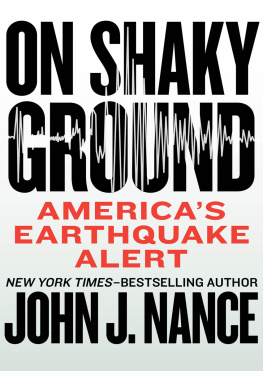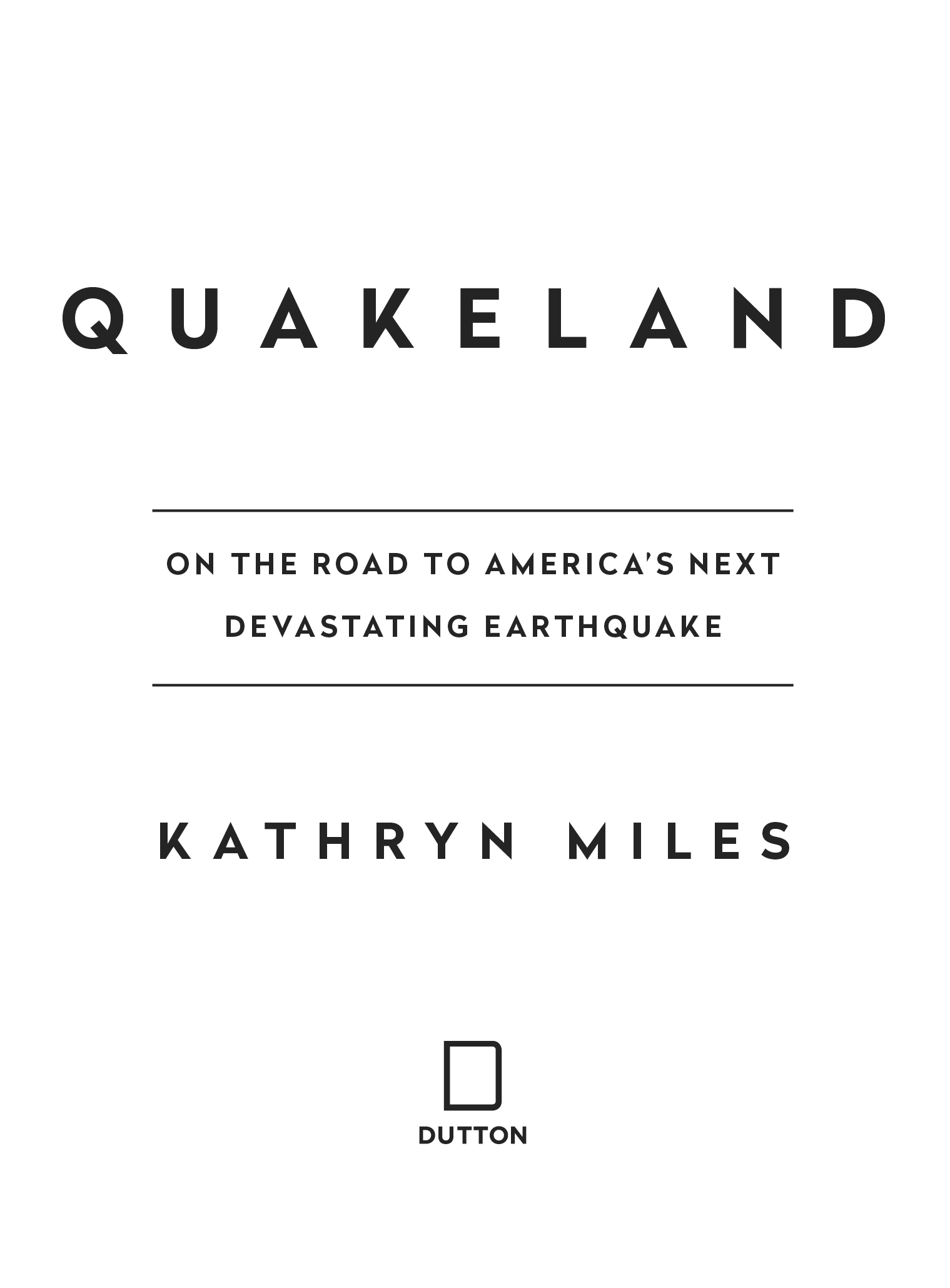
An imprint of Penguin Random House LLC
375 Hudson Street
New York, New York 10014

Copyright 2017 by Kathryn Miles
Penguin supports copyright. Copyright fuels creativity, encourages diverse voices, promotes free speech, and creates a vibrant culture. Thank you for buying an authorized edition of this book and for complying with copyright laws by not reproducing, scanning, or distributing any part of it in any form without permission. You are supporting writers and allowing Penguin to continue to publish books for every reader.
DUTTON is a registered trademark and the D colophon is a trademark of Penguin Random House LLC.
LIBRARY OF CONGRESS CATALOGING - I N - PUBLICATION DATA
Names: Miles, Kathryn, 1974
Title: Quakeland : on the road to Americas next devastating earthquake / Kathryn Miles.
Description: New York, New York : Dutton, [2017] | Includes bibliographical references and index.
Identifiers: LCCN 2017011994 (print) | LCCN 2017022673 (ebook) | ISBN 9780698411463 (epub) | ISBN 9780525955184 (hardcover)
Subjects: LCSH: Earthquake predictionUnited States.
Classification: LCC QE538.8 (ebook) | LCC QE538.8 .M5387 2017 (print) | DDC 551.220973dc23
LC record available at https://lccn.loc.gov/2017011994
While the author has made every effort to provide accurate telephone numbers, Internet addresses, and other contact information at the time of publication, neither the publisher nor the author assumes any responsibility for errors or for changes that occur after publication. Further, the publisher does not have any control over and does not assume any responsibility for author or third-party websites or their content.
Version_1
For Jane and Mike, my bedrock
CONTENTS
It cannot be expected that an examination of the phenomena connected with this disturbance will throw any light upon the origin of earthquakes. Scientific men do not seem to have gained from the terrible earthquake that devastated the island of Ischia, one year ago, or from the great catastrophe of Krakatoa and the Straits of Sunda, one month later, much useful information in addition to that which they already possessed upon which to form new theories or reconstruct old ones. Whatever may be the causewhether it is the falling of the roof of vast subterranean caves or the raging of a molten sea in the interior of the earth or the contraction of portions of the earths crust caused by the gradual cooling of the entire ballthis fact is plain enough to unscientific persons, that such disturbances are beyond the control of men, and that the dangers that accompany them are best avoided by living beyond the limits of the earthquake and volcanic regions. Those who look back upon the experience of yesterday, either with fear or with curiosity, may well rejoice that their lots are cast in a country where earthquakes do no harm.
The New York Times, 11 August 1884
PROLOGUE
T wo years ago, a good friend returned from a mapmakers conference with a gift for me: an enormous poster of the world. On it, the oceans are the deepest black a printer can print. The continents are just a shade lighter. What illuminates the map itself is a rendering of every earthquake that has occurred in the past decade: white dots for the really big ones, yellow and orange for the moderate ones, red for the rest. Together these dots create arcs of fire that define the edges of all the planets tectonic plates. Plumes of light point to active zones in California and Alaska, Japan and India. Youd expect that, of course. But heres what that map also shows: burning embers up and down the East Coast of the United States and across Europe. Big patches of heat in the American heartland, along with Antarctica, Australia, and Greenland.
To my mind, this map best illustrates one very important fact: Earthquakes are everywhere.
Prior to writing this book, I had experienced two observable ones in my life, though neither of them really counts. The first occurred the summer I turned thirteen. My family was living in the Quad Cities then, and I had acquired my first job, which was selling subscriptions to the daily newspaper. Each day, a van would collect me and a half dozen other adolescents. The driver would give us each two dollars for dinner at McDonalds, and then wed be dropped off in a different neighborhood, where we were supposed to knock on every door and sing the praises of the paper to whoever answered. As it turned out, pretty much everyone who wanted to read the paper already had a subscription. So I took to pocketing my dinner money, ditching my bag of complimentary papers, and, instead of attempting sales, wandering up and down residential streets, imagining what life was like in cluttered duplexes and gated colonials. On one particularly sultry evening, I got back to the van just in time to hear that a strong earthquake had rattled the region: magnitude 5.1, the largest quake to hit the Midwest in over twenty years. Fans at a Detroit Tigers game had thought the stadium was going to collapse. Employees in a St. Louis high-rise reported that the building swayed back and forth. An entire apartment complex all the way over in South Carolina had been evacuated. I had felt absolutely nothing. In the days after, I replayed the evening over and over again in my mind, looking for some evidence that Id been in a quake. Hadnt I felt a shake? Heard dishes rattle in a nearby apartment? Seen power lines ripple? In truth, I hadnt seen or heard anythingnot even a dogs bark. I felt cheated.
The second quake occurred a few months before my thirtieth birthday. I was lying on a beach on Hawaiis Big Island, waiting out the appearance of a very stubborn great white shark nearby. Suddenly, the ground beneath me shifted an inch or so forward and then back. I looked up to see if anyone else had noticed. If they had, they didnt let on. Back in the hotel, the front desk clerk just shrugged and said, Earthquake, when I asked about it. Apparently, when you live on a giant volcano in the tropics, tremors are about as noteworthy as fresh bananas and sunny days.
I guess it could be worse. A neighbor of mine experienced a moderate quake in Maine during the throes of an ugly divorce. While he was working in the basement, he heard the dining room table screech across the floor and assumed it was his soon-to-be-ex-wife helping herself to the furniture.
Most Americans have earthquake experiences as lackluster as these. The country hasnt had a big one since 1989, when a violent quake rocked Northern California just as TV viewers were tuning in to watch Game 3 of that years World Series. As luck would have it, the series was between the San Francisco Giants and the Oakland As, which meant 67,000 people were in the stands instead of on highways and bridges. Hundreds of thousands more were at home, safely glued to their televisions. As it happens, every major network was also in the area, which meant that this quakesince named Loma Prietawas the first truly televised one in history. Around the world, tens of millions of viewers (35 million in the United States alone) tuned in expecting pregame commentary. Instead, they heard the panicked shouting of announcers and watched as fans stumbled out of the stadium. They kept watching as helicopters circled a section of Interstate 880 that pancaked in the quake, killing over forty people and trapping dozens more. They looked on with disbelief at footage of the Bay Bridge, where a fifty-foot segment had broken off and, incomprehensibly, a twenty-three-year-old and her brother attempted to drive over it. The car hung off the edge of the bridge for what seemed an eternity as a coast guard helicopter rescue team risked their lives to save the passenger (the driver died at the scene).





















